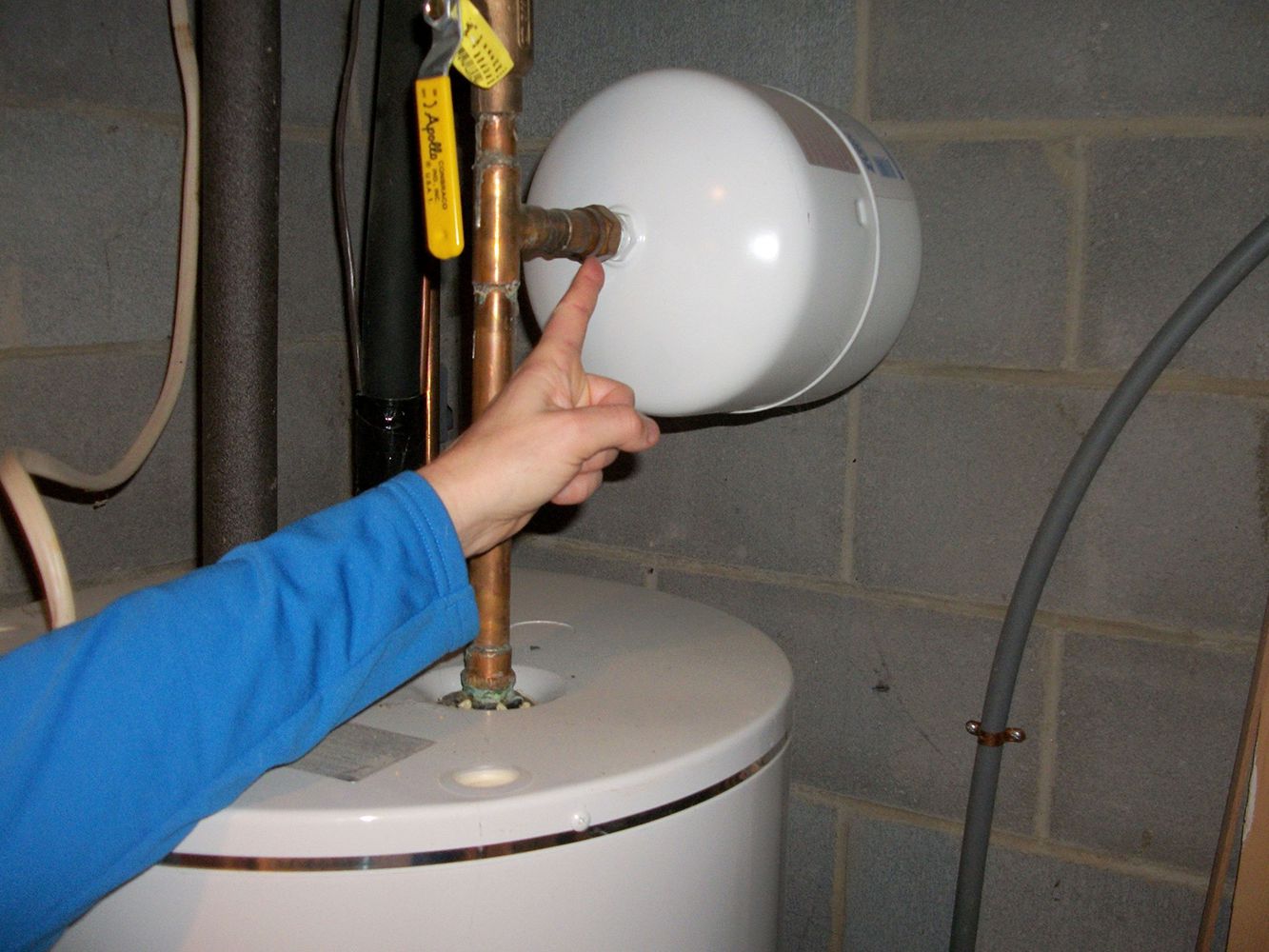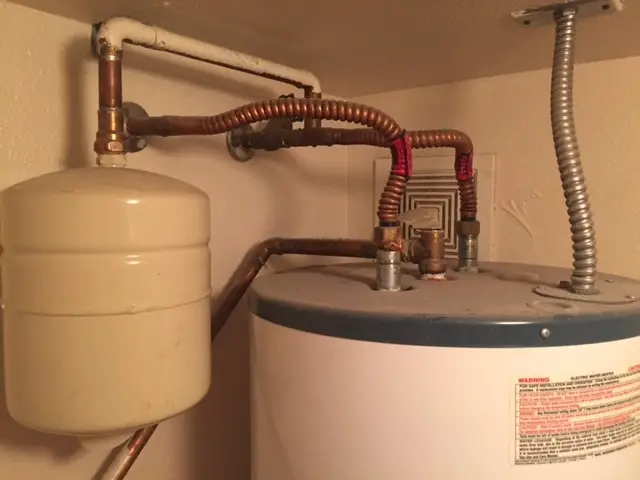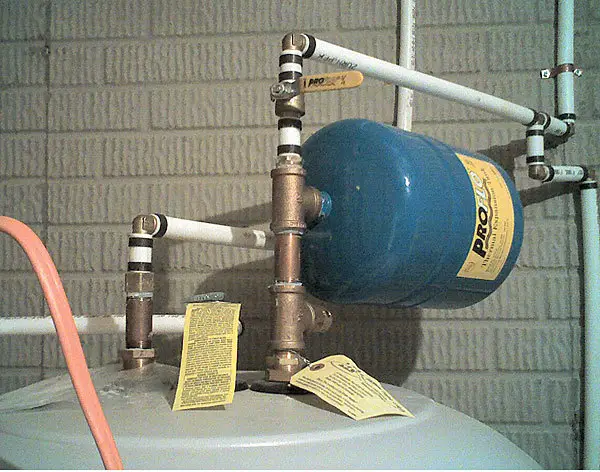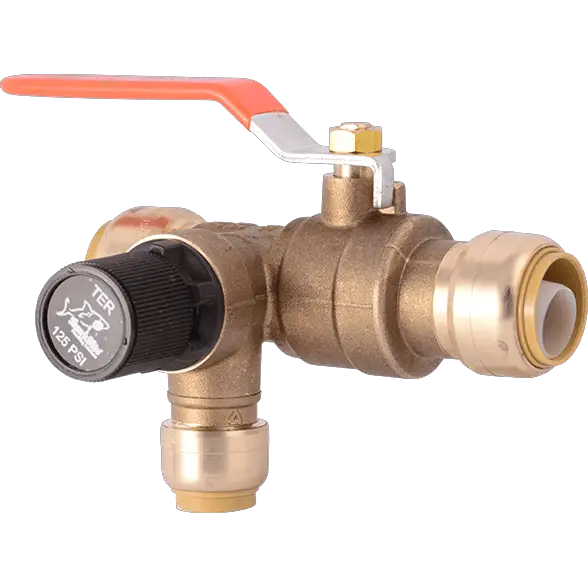Water heater expansion tanks are considered by many as safety appliances.
It works with a storage heating system, preventing sudden impacts from the city lines. It also deals with excessive volume due to thermal expansion.
In this article, you’ll read all about this HVAC accessory, which is often mandatory.

Water Heater Expansion Tank Terminology and Common Concepts
Before we start, here are some terms we’d like to make you aware of:
- Bladderless Closed Tank: Closed tanks, as you might expect, have no openings. Instead, this system has space for air inside. This air changes its volume as the temperature rises.
- Closed-loop plumbing system: It’s a home plumbing system that doesn’t allow water to drain back to the city lines.
- Closed Tank With Bladder: It’s the most common kind of tank in households. It works very much like the previous systems. Only now, a diaphragm or a bladder is separating the liquid from the air.
- Diaphragm or Bladder: It’s the rubber layer that separates liquid and air in the expansion tank.
- Relief Valve: This kind of valve is an alternative to deal with internal pressure. Instead of storing the exceeding volume, it drains it out of the system.
- PSI: The pressure in your system is measured in PSI (pounds per square inch). For reference, the pressure of one atmosphere is equal to 14.7 PSI.
- Open Tank: Open tanks have an opening on top of the outer side. As pressure builds in the system, the liquid inside this tank expands. It’s a rare model in HVAC appliances.

What is a Water Heater Expansion Tank?
Expansion tanks were designed to deal with the sudden increase in volume under specific temperatures. When it happens, the exceeding volume is absorbed by the extra tank, keeping your plumbing system safe. It’s a small tank which is placed next to the main one. This safety appliance is also known as a thermal expansion tank.
This kind of tank doesn’t only deal with hot temperatures, though. They shield your plumbing system against sudden overloads. They also benefit households with a closed-loop system. Closed-loop systems don’t allow this excessive water to go back to the municipal line, as open systems do. In this case, your plumbing system is much more vulnerable to excessive discharges. Here, a thermal expansion tank is advisable.
How Does a Water Heater Expansion Tank Work?
The primary function of this kind of tank is to equalize pressure within the system. Those tanks are smaller than normal ones. They can work with a rubber diaphragm that divides the heating system into two parts or with no diaphragm. On the other side, it contains pressurized air, and it’s completely dry.
As the system deals with hot water, it builds internal pressure. It happens because water expands when heated between 50°F and 120°F. This expansion corresponds to approximately 2% of its volume. Nowadays, pipes are designed to withstand this variation. Still, if the water volume increases too much, pressure will increase proportionally.

Such pressure affects the diaphragm, which is pushed down, leaving space for more water. Because it helps relieve pressure, they preserve pipes and heating parts for longer. In the worst cases, discharges can damage fixtures, valves, and pipes, causing unpredictable losses.
In the past, this excessive load of water would drain back to the city lines. But now, home pipes are different. Water doesn’t go back to the municipal lines again in a system called a closed-loop plumbing system. Because this water has nowhere to go, you need to empty its pressure with expansion tanks.
What Size Water Heater Expansion Tank Do I Need?
Once you’ve decided on this safety measure, you need to check your water system. It’s crucial to calculate the best water heater expansion for each case. Here, you should consider two variables: your main heater capacity and your plumbing system’s water pressure.
The first one, you can find stamped on your water heater. The second concerns how much pressure your system can handle. It can be easily measured with a gauge attached to a faucet when the water is on. This pressure is measured in PSI (pound per square inch). Generally, heaters with a capacity of up to 60 gallons require expansion tanks with storage capacity between 2 gallons and 3.2 gallons.
Pros of a Water Heater Expansion Tank
Installing expansion tanks on your systems is always advisable, and in some places, mandatory. In this section, you’ll read about the main benefits of this safety appliance.
Increases Your Water Heater’s Lifespan
Water heater units have pressure valves to deal with excessive pressure. Still, expansion tanks help your water heater absorb the extra volume, thus preserving its parts for longer.

Less Frequent Plumbing Repairs
Excessive pressure on your pipes leads unsurprisingly to many troubles. Such pressure can damage your pipes and fixtures and cause leaks. Expansion tanks keep your lines protected against sudden impacts.
Extended Capacity for Hot Water
Expansion tanks can increase the supply of hot water since now your system can deal with bigger volumes.
When the expansion tank is complete, this water goes to your system as soon as you turn on a fixture. Otherwise, it would be wasted.
Safety
A damaged pipe is not the worst thing that can happen with mishandled water pressure. It causes leaks that can damage your property and even put you in danger. In extreme cases, water tanks can explode with excessive pressure, with devastating effects.
Cons of a Water Heater Expansion Tank
There aren’t counter recommendations to this system. Most of the problems related to it come from improper installation. Still, some downsides deserve consideration. Here are two of them:
Some Models Need Recharging
Old expansion tanks are typically made of steel. With time, those old units tend to lose air and, consequently, internal pressure. You can fix it by recharging it with air.
Blocks Due to Malfunctioning
This system needs air to work, but air can also block the pipes, called a “hydronic airlock”. Expansion tanks should prevent this kind of thing. So, if it happens, there’s probably a problem with your tank.
Do I Need an Expansion Tank on My Water Heater?
There are a few issues to consider when deciding whether you need thermal expansion or not. It depends on your heating system, the conditions of your water supply, and even the building’s safety requirements. Read more about those reasons below.

If You Use a Storage Water Heater Appliance
Never neglect the obvious. If you use a tankless water heater, there’s no need for an expansion tank since you don’t use any tank at all. This system is only necessary for water heater tanks. The size of your thermal expansion will depend on the capacity of your water heater tank.
Your Home Water Supply Works Within a Closed-Loop System
A closed-loop system means that any excessive load of water from the city line won’t be draining back. So, whatever gets into your plumbing system will stay there. That’s when you need an expansion tank. It prevents this exceeding pressure from causing any damage to your property.
If It’s Required By Code
In some states, installing expansion tanks on closed-loop systems is mandatory. The UPC (Uniform Plumbing Code) and the IPC (International Plumbing Code) require a solution for hot water pressure. It could be an expansion tank or an expansion relief valve. Some buildings may also demand the installation of this system to preserve the building’s integrity.
Compatibility With Your Water Heater
Not all water heaters are compatible with expansion tanks. You’ll need to check the model of both and make sure you can actually install it on your one.
What About a Thermal Expansion Relief Valve?

Thermal expansion relief valves are installed directly on the heater tank. Thermal expansion relief valves aim to prevent excessive pressure to reach the tank in a closed-loop system. This device spills over vapor and water to control internal pressure. This kind of valve is installed when the water heater’s pressure is 100PSI. It’s an alternative to expansion tanks.
There are two ways of dealing with expansion pressure. You can use a containment solution or a discharging solution. The first one concerns expansion tanks, which “contains” the exceeding water volume.
The latter refers to relief systems where this exceeding volume is drained out of the system. This system works via an outside faucet or a water closet. Thermal expansion relief valves require the installation of drain pipes.
Cautious Considerations to Keep in Mind
Expansion tanks don’t waste anything, but they need maintenance. With time, the system loses air from inside the diaphragm, thus losing pressure. You’ll notice there’s something wrong with your expansion tank when it drips water from the pressure valve or by recurring airlocks in your pipes. Then, it’s time to recharge your tank.
You must watch for potential signs of trouble, such as frequent air blockages or leaks. Those are signs that your expansion set needs repair or replacement. Ask a professional to assess the situation.
Finally, ensure that your water heater type is compatible with expansion tanks, as you may damage both units. Furthermore, check if it’ll work with your open or closed-loop plumbing system, as you may be wasting money and time.
Conclusion
Expansion tanks are highly advisable, even when they’re not mandatory. It’s crucial to employ some pressure management system in the household. It could be an expansion tank or a relief valve. They protect your plumbing system and fixtures. It also helps to prevent collateral losses due to leaks or bursts. Before buying your expansion set, you must check your tank’s capacity and output pressure.
People Also Ask
Do you still have questions about expansion tanks? You’re not the only one. In this section, you can read some more detailed information about this issue.
The average cost of installing this kind of heater ranges between $145 and $350. If this service comes from your contractor, the average price is around $265. If you have the tools and knowledge to do it yourself, the estimated expense drops to $50.
It’s possible to install an expansion tank both on your cold and hot water lines. If you decide to install on the cold water line, there’s no specific distancing. It can be installed anywhere between the heating system and the main valve. Now, if you decide to install the hot water line, it should no less than three feet and no more than five feet away from the heater.
Thermal expansion tanks are liable to wear and tear, like any other appliance. Even more so because it deals with the excessive pressure from the system. If it happens to leak, this leak can come from the pipe or the tank itself. The first case is easily repairable with a wrench. The second may require professional assistance and, perhaps, replacement.
Typically, a thermal expansion tank can last between five and 10 years. This time can be optimized or shortened, depending on the pressure consistency of your water supply. If you manage to control the pressure on your plumbing system, expansion tanks can last longer. Yet, if they deal with constant impacts from the municipal line, they may have a shorter lifespan.
It depends on your water heater tank capacity. A two-gallon expansion tank can adequately serve a water heater tank of 50 gallons. If you have bigger tanks or more than one tank, you should calculate how many expansion tanks you need, proportionally.
It can work both ways. But, if you’re installing it to reduce pressure due to water expansion, it is advisable to install where it occurs: on the hot water pipeline. Still, if your plumbing system has to deal with frequent bursts of water, an expansion tank can be of good service on the cold water line.
